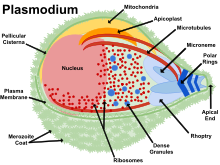
Back Protozoosi Catalan Protozoeninfektion German 原虫 Japanese Protozoose Portuguese Протозойные инфекции Russian Протозойні хвороби Ukrainian Protozoy kasalliklar UZ 原虫传染 Chinese

Protozoan infections are parasitic diseases caused by organisms formerly classified in the kingdom Protozoa. These organisms are now classified in the supergroups Excavata, Amoebozoa, Harosa (SAR supergroup), and Archaeplastida. They are usually contracted by either an insect vector or by contact with an infected substance or surface.[1]
Protozoan infections are responsible for diseases that affect many different types of organisms, including plants, animals, and some marine life. Many of the most prevalent and deadly human diseases are caused by a protozoan infection, including African sleeping sickness, amoebic dysentery, and malaria.
The species originally termed "protozoa" are not closely related to each other and only have superficial similarities (eukaryotic, unicellular, motile, though with exceptions). The terms "protozoa" and "protist" are usually discouraged in modern biosciences. However, this terminology is still encountered in medicine. This is partially because of the conservative character of medical classification and partially due to the necessity of making identifications of organisms based upon morphology.
Within the taxonomic classification, the four protist supergroups (Amoebozoa, Excavata, SAR, and Archaeplastida) fall under the domain Eukarya. Protists are an artificial grouping of over 64,000 different single-celled life forms. This means that it is difficult to define protists due to their extreme differences and uniqueness. Protists are a polyphyletic [(of a group of organisms) derived from more than one common evolutionary ancestor or ancestral group and therefore not suitable for placing in the same taxon][2] a collection of organisms and they are unicellular, which means that they lack the level of tissue organization which is present in more complex eukaryotes. Protists grow in a wide variety of moist habitats and a majority of them are free-living organisms. In these moist environments, plankton and terrestrial forms can also be found. Protists are chemoorganotrophic [organisms which oxidize the chemical bonds in organic compounds as their energy source][3] and are responsible for recycling nitrogen and phosphorus. Parasites also are responsible for causing disease in humans and domesticated animals.
Protozoa are chemoorganotrophic protists and have three different ways of acquiring nutrients. The first method of acquiring nutrients is through saprotrophic nutrition. In saprotrophic nutrition, nutrients are obtained from dead organic matter through enzymatic degradation. The second method of acquiring nutrients is through osmotrophic nutrition. In osmotrophic nutrition, nutrients are obtained through absorbing soluble products. The third method of acquiring nutrients is through holozoic nutrition. In holozoic nutrition, solid nutrients are absorbed through phagocytosis.[1]
Some protozoa are photoautotrophic protists. These protists include strict aerobes, and use photosystems I and II in order to carry out photosynthesis which produces oxygen.[1]

Mixotrophic protists obtain nutrients through organic and inorganic carbon compounds simultaneously.[1]
All cells have a plasma membrane. In a protist, the plasma membrane is also known as the plasmalemma. Just below the plasma membrane, and in the inner fluid region, cytoplasm can be found. The pellicle structure in the protist is a thin layer of protein that helps provide the cell with some support and protection. In addition to the plasma membrane, protists contain two different types of vacuoles. Contractile vacuoles help to maintain osmoregulation, and phagocytic vacuoles allow select protists to ingest food. In some protists, flagella or cilia may be present to help with motility and nutrient intake. The flagella or cilia create water currents that assist in feeding and respiration. Energy intake is necessary for protists’ survival. Aerobic chemoorganotrophic protists produce energy through the use of their mitochondria. The mitochondria then generate energy for the protist to keep up with cellular life functions. Photosynthetic protists produce energy through the use of their mitochondria and chloroplasts. Finally, anaerobic chemoorganotrophs produce energy through the use of hydrogenosomes, which are membrane-enclosed organelles that release molecular hydrogen (H2).[1]
Encystment is when a protist becomes a dormant cyst with a cell wall; during encystment, the cyst has decreased complexity and metabolic activity relative to the protist. Encystment protects the protist from environmental changes, the cyst can be a site for nuclear reorganization and cell division, and it can act as a host cell in order to transfer parasitic species. Excystment is when a return to favorable conditions may cause a cyst to return to its original state. In parasitic protists, excystment may occur when the cyst is ingested by a new host.[1]
Protists reproduce asexually or sexually. If the protists reproduce asexually, they do so through binary fission, multiple fission, budding, and fragmentation. If the protists reproduce sexually, they do so through a syngamy process where there is a fusion of the gametes. If this occurs in an individual it is recognized as autogamy. If this occurs between individuals, it is known as conjugation.[1]
- ^ a b c d e f g Wiley, Sandman, Wood, K, J, D (2020). Prescott's Microbiology. McGraw-Hill Education.
{{cite book}}: CS1 maint: multiple names: authors list (link) - ^ "Definition of POLYPHYLETIC". www.merriam-webster.com. Retrieved 2019-11-12.
- ^ "Definition of CHEMOORGANOTROPHIC". www.merriam-webster.com. Retrieved 2019-11-12.